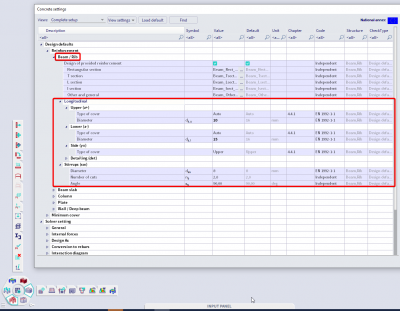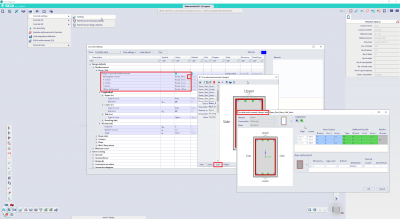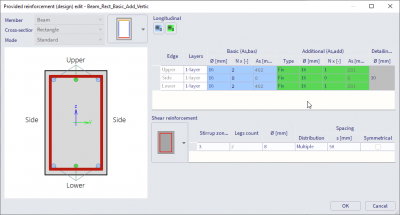Types of reinforcement
When designing reinforced concrete members in SCIA Engineer, you will come across several different types of reinforcement. Are you not familiar with them all? Here is an overview, with a simple example of a reinforced concrete beam, to help you navigate easier through the design process.
We have described the individual types of reinforcement below. They are structured in a way that follows a common workflow used for the design of reinforcement in concrete members.
Required Reinforcement
Required reinforcement (As,req) is determined by the program in Workstations > Concrete > Concrete settings > Design defaults > Reinforcement
It is the sum of the statically required reinforcement (the longitudinal reinforcement determined for the effect of a combination of N+My+Mz+Vy+Vz and the longitudinal reinforcement designed for the effect of a tensile force due to shear and torsion) and the reinforcement designed as per detailing provisions.


Provided Reinforcement: Basic and Additional
Provided reinforcement (As,prov) is used during the reinforcement design process. The provided reinforcement is created by the program based on your input made in Concrete settings > Design defaults or in 1D member data.

The total provided reinforcement is calculated by the program as the sum of provided basic and provided additional reinforcement (As,prov = As,bas+ As,add,prov):
- Provided basic As,bas is the basic reinforcement that is constant along the whole length of the beam – typically the corner rebars.
-
Provided additional As,add,prov is the additional reinforcement that is used only in those parts of the beam where the basic reinforcement is not sufficient. This means that the additional reinforcement is not constant along the whole length of the beam.
The number of bars of the provided additional reinforcement can be specified in two ways:
The first option allows you to define strictly the number of bars of the provided additional reinforcement (e.g. n = 2). (Please note that if the program calculates that any provided additional reinforcement is needed, it always inputs the number of bars you defined, regardless of whether the amount is sufficient or economical).


The second option enables you to specify a set of options, i.e. a list of possible numbers of bars (e.g. n =0, 2, 3), that can be used for the provided additional reinforcement. In this case, if the provided additional reinforcement is needed, the program evaluates individual options from the list (possible number of bars mentioned above) and uses the first number of bars that satisfy the condition of the required amount of provided additional reinforcement.


Additional reinforcement
Additional reinforcement (As,add,req) is determined by the software if the provided reinforcement (based on its current settings) does not sufficiently cover the required reinforcement. It is calculated as the difference between the required reinforcement and the provided reinforcement. In other words, it is the reinforcement that must be added to the provided reinforcement to meet the needed amount of the required reinforcement.

All the above-mentioned types of reinforcement are considered in the reinforcement design; however, none of them is taken into account in the reinforcement checks of concrete members. To perform the reinforcement check, you must specify the practical reinforcement.
Practical reinforcement
Practical reinforcement enables you to perform the reinforcement check. You can define it using commands from the Design > Concrete > Concrete 1D > 1D reinforcement design. It is also possible to create practical reinforcement based on the provided reinforcement with the action button 'convert to real bars'.
